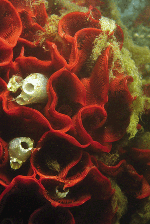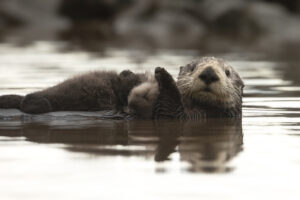Although seven bridges span its breadth and many ships ply its waters, our view of what lives beneath the opaque surface of San Francisco Bay is surprisingly limited. Like many before him, photographer-cum-diver Dennis Anderson had been frustrated in his efforts to photograph its underwater creatures by the notorious turbidity of the Bay. But then he heard rumors of clear water in the Richmond Inner Harbor, a place largely sheltered from the pull of currents and the churn of waves.
Here, in still, deep waters, where sediment that has washed down from the hills and out from the Central Valley can settle out, Anderson found a largely unexplored world pulsing with life, full of curious forms and bright colors. Juvenile smelt (Atherinopsis californiensis) school near the surface, flashing silver as they dart after algae and detritus. Below, anemones (order Actinaria) deploy their crowns of entangling tentacles armed with nettle-like nematocysts that sting and paralyze unfortunate passersby…
Yet another common harbor resident is a type of sedentary tunicate called a sea squirt (Ciona savignyi). This tunicate gets its nourishment by siphoning water in and out through the trumpet-like openings in the translucent, gelatinous tunic from which it gets its name; food particles are trapped in a mucous net within the oral cavity. The colonial golden-star (Botryllus schlosseri) is another species of tunicate; it blankets ship hulls, kelp blades, and mussel shells in honeycombed sheets of as many as 1,000 individuals. Within each colony, tunicates are arranged in star-systems — elliptical groupings of six to 12 individuals. Each star-system shares a centralized cloacal opening to excrete waste products, an extreme example of aggregate organisms working together.
- Photo by Dennis Anderson
Down here amid the harbor pilings, the limiting factor is space on which to anchor, and every surface is prime real estate. Competition is stiff for a foothold and a meal. Even the shell of a mussel (Mytilus sp.) glued fast to a pier becomes a substrate for an opportunistic orange colonial tunicate, while sponges crowd in on all sides. (A tunicate is classified as a chordate since it has a notochord, a dorsal nerve chord, and gill slits in its larval stage; sponges are simpler, multicellular animals lacking nerve and muscle cells.) Some sponges release toxins to ward off squatters, while tunicates can overgrow and smother their neighbors.
Lashed to the rocks with adhesive threads, bivalves like the mussel crack a smile, sweeping the current with their gills. At the first sign of danger, the hinged shell snaps shut, powered by strong adductor muscles. Serpulid polychaete worms entrench themselves in warrens of self-secreted calcium tubes. Thus cemented to a hard surface, they extend feather dusters to filter particulate food out of the passing current.
Scattered throughout, a rime of golden sponge (order Haplosclerida) spreads like oceanic rust. Bryozoans such as the leafy red Watersipora foul dock pilings and rocks alike. These colonial organisms are sheathed in exoskeletons through which they extend their lophophores (tentacles) to feed on food particles suspended in the water column.
It is humbling to realize how little we know about the residents of our watery backyard. We don’t even know enough about many of these invertebrates to identify them with certainty (some creatures are hard enough to identify to phylum, let alone to the level of genus and species, without close inspection), much less understand the roles they play in the complex estuarine eco-system of the Bay. But that doesn’t mean we can’t be dazzled by their beauty. As Anderson’s photos remind us, the Bay remains an intriguing frontier to be protected and explored.

.jpg)




